I’ve always been a stickler for good grammar. I loved English Language at school – it was my favourite subject. I did really well at it too – I got A+ in my O’ Levels (OK, so I’m proving my age) and in my A Levels and I even took S Level English, although I don’t think this certification even exists anymore!
It’s a standing joke in the office when it comes to my checking of other peoples’ creative work, such as an article or a blog or a quirky campaign idea one of the team has written and passed my way. David tells me I get all ‘school ma’am-ish’ when I’m assessing its level of perfection, with my red pen poised, ready to strike through any word or phrase that just doesn’t look quite right!
But does grammar really matter in today’s business world?
It’s certainly a hot topic in educational circles and I’m with Customer Plus on this one – I think it should matter in business too. May’s #FridayThink article from Customer Plus referred to grammar in the written word being akin to body language. Apparently, it communicates your personal style, your attention to detail and your attitude to others. A badly worded or poorly punctuated email diminishes the writer they say. It marks him or her out as unprofessional and sloppy – yes, I agree!
Research shows that we each send as many as 120 emails a day. That’s 120 chances to create an impression. Emails are studied much more closely than brochures, websites and advertisements yet they receive a fraction of the time in copy writing and checking. Less is more when it comes to the written word. We don’t have to use 20 words when 10 will do. We should be following the KISS Principle (Keep It Simple and Straightforward) with our writing, exactly as we should do with the spoken word.
Psychologist Daniel Oppenheimer examined the complexity of the vocabulary used in passages from various kinds of texts, then asked people to read the samples and rate the intelligence of the person who allegedly wrote them. Simpler language resulted in significantly higher ratings of intelligence, showing that the unnecessary use of complex language actually sends out a bad impression!
There are some really easy-to-follow rules of Netiquette that I’m going to share with you in this week’s blog. I want to get you thinking passionately about your ‘written voice’ just as we encourage our clients to think about their ‘spoken voice’, when we’re working with frontline teams, who represent their brand on the telephone.
Do you appreciate the impact of your written communication on your brand? Do you see how badly worded requests or instructions can result in expensive mistakes? How well trained in grammar and punctuation are you?
Do you know the difference between the passive and the active voice and when and where each one should be used in writing? Do you often confuse your ‘there’s’ from your ‘theirs’ or your ‘objectives’ from your ‘objections’ or misplace the apostrophe? In today’s technologically advanced world, there’s just no excuse for poorly written communication – bad grammar or misspelt words or incorrect punctuation are a cardinal sin in my opinion!
OK, I do appreciate I’m a little OCD when it comes to good grammar (in both the written AND the spoken word) but we can all improve and hone our written communication by following these 10 Golden Rules of Netiquette:
10 GOLDEN RULES OF NETIQUETTE
1. Remember, people are glancers not studiers! First and last impressions are vital so set the scene in the first paragraph and call for action or a look-forward in the last paragraph. We never get a second chance to create a good first impression and a last impression is lasting so make it a positive one.
The ‘subject’ box should immediately inform the reader exactly what the email is about – a short summary that attracts attention when the reader skims the email upon receipt.
2. Follow the K.I.S.S principle! Keep it simple and straightforward – don’t use 20 words when 10 will do and keep sentence structure and paragraphing easy on the eye and simple for the reader to read.
Apply the Dual Readership Path principle (bolding to highlight key words, calls for action etc.) which is equally useful for Golden Rule no. 1, making it even easier for the glancer.
If your reader is known to you, mirror and match them – write in a style your reader can relate to and in a language they can easily make sense of.
3. Remember that words paint pictures! The reader will make sense of the written word through building pictures in their mind from what they see in black and white. Use positive language to create a positive tone and interpretation of the message in writing and watch those R.I.P phrases and jargon busters……‘don’t hesitate to contact me…’ / ‘sorry for the delay in replying to you’ / ‘unfortunately I’m unable to confirm….’ / ‘I’m afraid we’re unable to put this on an option for you..’ and remember to deliver bad news positively using the Tape Technique – write about what you can do before you write about what you can’t do!
4. Watch your P’s and Q’s! Take care with slang, symbols (e.g. &), clichés and abbreviations – numbers should be typed as words if used to start a sentence or are low numbers (e.g. ’10 years ago….’) and quotation marks should always be used for directly quoted speech or text. Dashes (-) are good for adding emphasis to the written word and simplifying sentence structure.
5. Use the name to focus attention! Precede both good and bad news with the person’s name, however care with overuse. It looks as bad in writing as it does being spoken! Remember to spell the name correctly. It’s bad enough to say it incorrectly, although it’s even worse to spell it wrongly!
6. Create the WIIFY’s! If you need the reader to take action of any kind, ensure you communicate ‘what’s in it for them’ in doing so! The power of the WIIFY lies in letting the reader know the benefit of taking action before commanding them to do so!
7. Follow the UPOD Rule If agreeing to any action yourself, in order to manage customer expectations and your own stress levels, learn to ‘under promise’ so that you’re always able to ‘over deliver’. Remember those 3 little words ‘ before’ ‘by’ and ‘within’ as a means of creating flexibility of response times and easing the pressure from your busy work schedule.
8. Check it out! Communication through the written word is more concrete than the spoken word so there is less margin for error or mistakes! Spell and grammar check everything every time but be aware that the system is not fool-proof and common-sense checking using a manual dictionary or thesaurus may also be required!
9. Beware – once it’s written down, it can’t be taken back! So if you’ve got a contentious or difficult message to relay, try one of these 3 routes first: 1. Pick up the ‘phone instead 2. Don’t reply immediately – take time to gain control and think rationally 3. Try reading back the email you’ve prepared in a sarcastic tone (out loud) – if you can do this, then you need to change your wording before hitting that ‘send’ button!
10. Perform the daily Triage Act When receiving email, remember the golden rule – touch it only once! Do something with it the first time you open it, otherwise you’ll waste time skimming repeatedly through the same email before doing anything with it! So, perform the daily Triage Act and notice how much time is saved! ACTION IT! or DELETE IT ! or FILE IT!
Remember – language is the dress of thought and our words are the clothes that our thoughts wear so we should dress them well – especially in writing!
Until next time…..keep FIT!


















